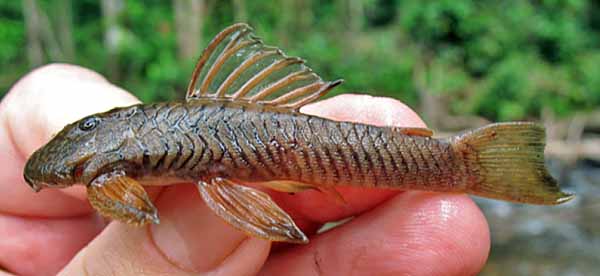Guyanancistrus nassauensis
Mol et al., 2018
|
Familie: Loricariidae |
Typen
Holotypus: MHNG 2679.100.
Paratypus: AUM 50388 (14), 50396 (16), 50740 (6), 50737 (4), 50763 (2); MHNG 2745.064 (2), 2679.099 (4), 2690.022 (1 postlarve); NZCS F 7095 (1), F 7096 (1), F 7097 (1), F 7098 (1).
Typusfundort: Surinam: Sipaliwini: Paramaka Creek, Marowijne River Einzug, Nassau-Gebirge 4˚51'36"N, 54˚35'30"W (Karte).
Etymologie
Der Name nassauensis ist ein Verweis auf die Verbreitung der Art, die nur in Bächen in den Nassau-Bergen bekannt ist, ein Gebiet, das jetzt von einer geplanten Bauxitmine und illegalem Goldabbau bedroht ist.
Verbreitung
Guyanancistrus nassauensis ist nur aus dem Paramaka Creek und einigen seiner Nebenflüsse, im Marowijne River Becken, in den surinamischen Nassau Bergen bekannt (eine Fläche von ca. 20 x 20 km2). Auf einer Höhe von 277 m befindet sich die Typuslokalität in einem nördlichen Abzweig des Paramaka Creek, einem mittelgroßen und flachen Bach (3-7 m breit; weniger als 50 cm tief) mit Tümpeln und einigen Riffelhabitaten und einem felsigen Substrat. Er ist begrenzt durch einen Festlands-Regenwald. Das Wasser war bei der Aufsammlung transparent mit einem mittleren pH-Wert von 6,26, einer Leitfähigkeit von 24,2 μS / cm und einer Temperatur von 23,2 °C.
IUCN Status

CR Critically Endangered (vom Aussterben bedroht)
EN Endangered (stark gefährdet)
VU Vulnerable (gefährdet)
NT Near Threatened (potenziell gefährdet)
LC Least Concern (nicht gefährdet)
RE Regionally Extinct (regional oder national ausgestorben)
DD Data Deficient (ungenügende Datengrundlage)
NE Not Evaluated (nicht beurteilt)
Status: Stand 17.01.2018: NE Not Evaluated (nicht beurteilt)
Grund für die Gefährdungseinstufung: (nicht beurteilt)
Literatur
- Mol, J.H.A., de Mérona, B., Ouboter, P.E. & Sahdew, S. 2007. The fish fauna of Brokopondo Reservoir, Suriname, during 40 years of impoundment. Neotropical Ichthyology, 5 (3):, 351–368. (doi) Zitatseite [: 112, als Guyanancistrus sp. "big mouth", Fundort]
- Wan Tong You, K. 2007. Appendix 15. Observations on the behavior of Harttiella crassicauda and Guyanancistrus n. sp. (‘big mouth’) of Nassau Mountains in the aquarium. P.. 249 in: {{aut|Alonso, L.E., Mol, J.H.) (eds.): A Rapid Biological Assessment of the Lely and Nassau Plateaus, Suriname (with additional information on the Brownsberg Plateau). 43. Arlington, USA: Conservation International. Zitatseite [: 249, als Guyanancistrus sp. "big mouth", Aquariumhaltung]
- Covain, R. & Fisch-Muller, S. 2012. Molecular evidence for the paraphyly of Pseudancistrus sensu lato (Siluriformes, Loricariidae), with revalidation of several genera. Cybium, 36 (1): 229-246. [Guianas%20colour.pdf (PDF)] Zitatseite [: 233, als Pseudancistrus sp. "Nassau", molekular Phylogenie]
- Covain, R. & Fisch-Muller, S. 2012. Molecular evidence for the paraphyly of Pseudancistrus sensu lato (Siluriformes, Loricariidae), with revalidation of several genera. Cybium, 36 (1): 229-246. [Guianas%20colour.pdf (PDF)] Zitatseite [: 244, als Guyanancistrus sp. "Nassau", Gattungsstellung]
- Mol, J.H.A. 2012. The freshwater fishes of Suriname. Koninklijke Brill, NV, Leiden, 889p. Zitatseite [: 450–451, als Guyanancistrus sp. "Bigmouth", Kurzbeschreibung, Abbildung]
- Mol, J.H., Vari, R.P., Covain, R., Willink, P.W. & Fisch-Muller, S. 2012. Annotated checklist of the freshwater fishes of Suriname. Cybium, 481: 263–292. Zitatseite [: 274, 286, als Guyanancistrus sp. "Nassau", Vorkommen in Surinma, bedrohte Art]
- Fisch-Muller, S., Mol, J.H.A. & Covein, R. 2018. An integrative framework to reevaluate the Neotropical catfish genus Guyanancistrus (Siluriformes: Loricariidae) with particular emphasis on the Guyanancistrus brevispinis complex. PLoS ONE, 13 (1): e0189789: 1-66. (doi) Zitatseite [: 37, Figs. 6e, 12, 18b, !!]
